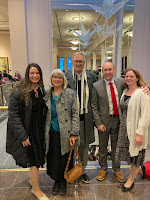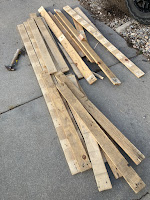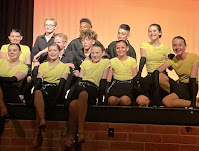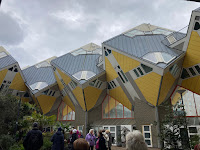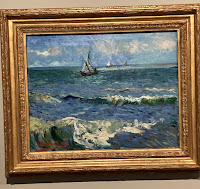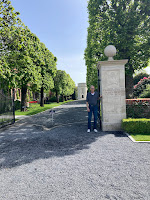APRIL 2024
 |
Salt Lake Temple
|
 |
| Heber Ferraz-Leite Family |
 |
| Conference Center |
We started the month with listening to and attending the Saturday night Session of General Conference for The Church of Jesus Christ of Latter-Day Saints. We were so excited to hear the announcement of about 18 vocalists from all over the world being selected to participate as guest performers for the next 5 years with the Tabernacle Choir and one of the participants being Heber Ferraz-Leite from Vienna Austria. His son, far right in the photo was one of our Young Adults when we were in Vienna.
One of the highlights of Saturday evening was meeting up with friends from Cumorah Academy. Russell and Samantha Ford who were Mentors for a week came from England with their family and Nicole from El Salvador one of the students who is in Utah for about 3 months met up with us for a few minutes. It was so fun connecting with them and getting a photo together.
President Russell M. Nelson was the concluding speaker of the conference. He is 99 years old and so inspiring. He announced 15 more Temples to be built around the World with two more in Utah - South Jordan and Lehi. He shared that when he was born there were 6 Temples in the World and today there are 350 temples in various phases, which includes 189 dedicated temples, 52 under construction, and 109 others announced. The very first Temple built by the early saints was in Kirtland, Ohio. It has been owned by the Community of Christ Church for the past 150 years. Last month they sold it back to the Church with several additional properties, artwork and original documents. We have waited a long time to have this happen and to have the Church now conduct the tours of these properties and to be able to tell our story. Pres. Nelson shared the historical significance of the Temple and what took place in Kirtland that paved the way for the ordinances and procedures in Temples today. He shared that a Temple is a house of prayer, fasting, faith, learning, glory, order - a House of God.
He said, "You do not have to face life alone - Angels really will help you." I know this to be true. I am so grateful to have been blessed by the Angels in my life.
The Salt Lake Temple dedicated in 1893 is the largest Latter-day Saint temple by floor area. It is the sixth temple completed by the church requiring 40 years to complete. It has been closed for major seismic renovations for the past 5 years and is nearing completion in 2026. This month the Angel Moroni was reinstalled on the spire of the Temple. The picture at the top shows it back in all of its majesty. It is one of the iconic features of a Latter-day Saint temple. The Salt Lake Temple angel Moroni is 12 feet, 5 inches tall with a steal rod going 27 feet down into the building. There is also a 4,000 pound counterweight at the bottom, ensuring that the angel will withstand extreme weather conditions.
We had the opportunity to attend the Timpanogos Symphony Orchestra featuring Brian Mathias, Tabernacle organist. It was a delightful evening of symphony music and organ.
We love living in a place that has so much to offer in the Arts.
Our dear friend, Sharon Lloyd plays the cello with the Davis County Celebration Orchestra. They had their Spring concert combined with the Davis master Chorale and the Utah Youth Singers. The Orchestra's featured number was
Requiem by Gabriel Faure'. We invited my sister, Pam and had a delightful evening of dinner and music together.
SPRING HOME PROJECTS
Last Spring we painted and put a temporary roof on the gazebo in our back yard. It looked really nice and served us well for the Summer. The Tarp roof did not survive the Winter winds and weather and was deteriorating. We looked at different options and decided to put on a wood roof putting it back to its original design. We found free wood pallets and began the month long project of taking them apart, removing all of the nails, painting and then cutting to fit. We needed 80 pieces of wood - thats a lot of pounding nails! We worked together and had a good system. We were about 15 pieces short and I found a man selling pallet wood already disassembled for $.50 each - What a deal. Saved us a lot of time and work.
Next step was to paint the wood. We used rain gutters for the paint and dipped each piece and wiped with a brush. It worked really good.
 |
Wood painted and drying
|
COMPLETED PROJECT!
The roof is restored to the original look with a wood roof. It looks really nice and should last for many years. I measured, Russ cut and I nailed them in. Two days on a ladder is hard on your feet. I can't say it is water tight, but it is a great place to be out of the sun and to enjoy our back yard with an awesome view of the mountain. We can grow old in those rocking chairs!
Sunday we were able to gather with my sister Pam's family to celebrate the Mission call of her granddaughter, Leah. She will be leaving in May for the Mexico City North Mission. She spoke in church on Sunday and then they had a delicious luncheon for family and friends. It was a beautiful day and so nice to be with family.
Leah has been preparing to serve a mission for many years and she will be a dedicated, hard working, fun, spiritually minded Sister Missionary.
GRADUATION
The time has come for many of our mission family to graduate from Universities and move on in their lives. We had a Graduation Dinner and celebration to wish them well as they embark on new careers and adventures. We are so proud of them and all of their accomplishments and are so blessed to have been a small part of their journeys. We will miss these gatherings and look forward to watching what the future has in store for them. We have 4 BYU graduates and 1 Utah State.
Spencer, Cambree, Kaja, Jesse, Cooper, Elli, Grace, Caleb and Riley - Thank you for blessing our lives.

We were able to attend the graduation ceremony for Elli on Thursday. She graduated in the College of Physical and Mathematical Sciences. What an impressive group of graduates. This is one smart group of people. 7 Valedictorians - they had to pick just two to speak, 2 offered the prayers and three performed a musical number so that they could all be included on the program. It was wonderful to cheer for Elli and to be able to share in this special day with her.
 |
| Elli Vickers |
SPRING BALLROOM TEAM PROGRAM
Granddaughter, Preslee had her Spring program and it was FANTASTIC! The 7-9th grade teams have made so much progress during the year. It has been so fun attending her competitions and to see the culmination of the years work in this show. Preslee is on the front row second from right - always standing out in the crowd!
She performed in the Walz above - this was the first time they got to wear costumes and not just competition dresses. She said, "I want to get married in this dress". She felt so beautiful all dressed up.
She also performed the Triple Swing and the Cha Cha.
Emily volunteered to prepare the light dinner for the dancers before the program. Of course that means I was involved. We made delicious Green Chili Chicken Taquito’s, Salsa with Chips, and fresh fruit. Always fun to be involved.
GERMANY, NETHERLANDS AND BELGIUM
We are off for a week in Germany, Netherlands and Belgium. Tulips are one of my favorite flowers and I have always wanted to go to the Netherlands and see the tulips and the windmills. I hope you enjoy this PHOTO BOMB of our trip.
In Dallas waiting for our flight to Frankfurt Germany.
It is always an adventure for us to fly. We always hope for just a seat on the plane as we fly stand-by and this trip was the best we could hope for. No business travelers and we were able to sit in Premium Business Class. Russ getting all settled in. I was across the aisle from him. No better way to fly for a 10 hour flight. Great food, Movies, a great book to read and a nice few hours of sleep. We were ready to hit the road and continue our journey. I enjoy watching the interactive map showing the flight status. We arrived in Frankfurt at 8:00 AM giving us a day to travel to the Netherlands.
While our ultimate destination was Amsterdam to see the Tulips, we had other stops planned along the way that turned out to be highlights we had not planned on. We rented a car in Frankfurt - autobahn here we come - so good to be back driving in Germany!
For those who have been following my BLOG, you know our love of Cathedrals. So we begin our journey with a stop in Cologne Germany to see the COLOGNE CATHEDRAL.
Cathedral Church of Saint Peter
It is a renowned monument of German Catholicism and Gothic architecture and was declared a World Heritage Site in 1996. It is Germany's most visited landmark, attracting an average of 6 million people a year. At 515 ft. the cathedral is the tallest twin spired church in the world, the second tallest church in Europe after Ulm Minster,(visited in 2018) and the third tallest church of any kind in the world.
Construction began in 1248 but was halted in the years around 1560. Attempts to complete the construction began around 1814 but was not properly funded until the 1840's. It was competed to its original medieval plan in 1880. It became a "powerful testimony to the strength and persistence of Christian belief in medieval and modern Europe."
 |
| Stain glass at every window |
 |
Entry with intricate design work
|
The Cathedral suffered fourteen hits by aerial bombs during WWII. Badly damaged, it nevertheless remained standing in an otherwise completely flattened city. The twin spires were an easily recognizable navigational landmark for Allied aircraft bombing.
Repairs of the war damage were completed in 1956 with additional repairs in 2005.
In 2006 the authorities declared not to allow high rise buildings to be built around the cathedral.
Floor tiles inside of the Cathedral. While it is a historical wonder, it was not the most beautiful cathedral I have been in. Many tombs inside and not a lot of decorum outside of the beautiful stain glass windows.
The workmanship and detail of the doors and outside structure were impressive.
ROTTERDAM
We were welcomed to Rotterdam by The Falkena family. Sybren, their son served with us in the Alpine German Speaking Mission. We loved our time with him and spent many hours with he and his companions. We even got to see him after he was transferred to Switzerland and do his apartment inspection. They were so welcoming to us and provided the best dinner and topping it off with homemade apple tart and cream. We really enjoyed getting to know them and to reminisce with Sybren and catch up from the past 4 years. He is just finishing up many years of study to be a Nurse. He
graduates in June. So proud of him and look forward to seeing what his future brings.
We attended Church with them the next morning. We were met by 10 missionaries and other Ward members. It was such a friendly welcome and we met some wonderful people. They had translation for English and Spanish and we felt right at home. I love that we can travel all over the world and on Sunday find a congregation that has the same pictures, furniture, ordinances and procedures as all of the congregations of our Church. Sybren took us on a tour of Rotterdam and the outlying area for the rest of the day. What a treat to have a local guide that made it so fun.
We started at the town square. Rotterdam is a major port city in the Dutch province of South Holland.
It is home to Pilgrim Fathers Church where pilgrims worshiped before sailing to America. The city was completely destroyed during WWII and has been almost completely reconstructed. It is known for bold, modern architecture,
We started at the large city Shopping Center. The picture above shows items like dishes, containers, silver that were found from the former buildings that were destroyed when they began excavating for the new buildings.
Many of the buildings have been named by the locals due to their interesting architecture. To the left is called the
Pencil. Below is the entrance to Market Hall and is called the
Pencil Sharpener.
 |
| Pencil Sharpener |
 |
CUBE HOUSES
|
These apartments are amazing and cost about $1 million. Several are used as AirBnB and Hostels. It was fun to walk through and see them and enjoy the architecture wonder.
Lots of water and bridges. It is a major Port City that provides most of the employment in the region.
This is the new Train station and Metro center. It is called the
Whale. I think my son, Joshua would love seeing this city with all of the modern architectural features.
What a fun place to get a feel for all things Dutch. We were treated to the sights, taste and smell of the area. We were not willing to try the raw herring but the fresh made stroopwaffles were out of this world. I have only had the smaller store bought cookies and these fresh ones were amazing! They make a very thin large - about 6 inches - waffle. When it is done they slice it very thin in half and then fill it with fresh hot caramel and replace the top. So Delicious!
Then we tried their special fries or
Patatjes. This is their premier specialty. They are fresh cut and fried and then topped with their healthier mayonnaise, chopped onions and Peanut sauce. Amazingly delicious! I have not had french fries in over a year and it was worth it.
Our next stop was a twenty minute drive out to the Kinderdijk Windmills.
This was another highlight of the day. I had been driving for about 20 minutes and we were looking for a parking place. Sybren said, are you driving a manual - Yes. Greatest compliment he could give me that I was doing such a good job driving a manual car in a foreign country.
The Windmills were built to keep the low-lying land of the Alblasserwaard dry. Arranged opposite each other, they form an iconic Dutch image that is popular with many photographers.
This stone windmill is from 1738. The Nederwaard Museum Mill still makes its rounds nearly three centuries after it was built. This windmill quite literally revolves around the history of Kinderdijk and its unique windmill complex. Everything here breathes the atmosphere of ages past. Some of these windmills housed a family of up to ten children or more.
It was a very blustery day and we braved the wind and rain to go see the windmills. Oh, so worth it. We had a wonderful walk from the parking lot out to the dikes and then down through the windmills. I truly felt like I was in a dream and experiencing all things Holland.
You are below sea level here and the windmills would pump the water back to the rivers and sea to keep the crops safe from flooding. Today, they use large pumping stations to keep the land dry to prevent flooding.
 |
| Wooden Shoes. |
It would not be a trip to Holland without stepping into wooden shoes,
I had no idea there were so many styles of Wooden Shoes. The first is a Wooden Boot shoe. Next is wooden Skates, then Women's Pumps with a large heal, Sunday wooden shoes, Dike shoes, Garden Shoes, Fishing shoes and smugler Wooden shoes!
We checked into our Hotel after a short drive from Rotterdam to Noordwijk Netherlands - out in the country away from the city where the Tulip fields are.
We went to dinner in the little village - right on the beach and then drove around to get a feel for the area. It was so windy and cold but so fun to see the beach and the vibe of the surroundings with lots of restaurants and the giant ferris wheel.
 |
| Russ on the walkway to the Beach |
 |
Savory Pancake for lunch
|
All of the shops are open on Sundays and so most of them close on Mondays. We could only find a pancake house open for lunch and it did not disappoint. I had a savory ham, cheese, red onion and mushroom Dutch pancake. It was huge. it was about the size of a pizza and then you roll it and top it with syrup, powdered sugar or whatever you want.
After Sundays Blustery Day - it all blew out and Monday was a clear beautiful day - we were so blessed to be able to see the Tulips on a clear day.
KEUKENHOF
Celebrating 75 years: You discover the colorful past and blooming present of the international flower exhibition. With the dedication of generations of passionate individuals, Keukenhof has evolved into the most beautiful spring garden in the world. With the merger of the Keukenhof Castle Foundation and the international Flower Exhibition Foundation, The Count Carel van Lynden Foundation becomes the new owner of the entire estate.
Every October, the cycle of planting flower bulbs, blooming and dug up the bulbs begins all over again. The park is redesigned annually. They plant in three stages for early, middle and late blooming tulips so you always have some in bloom. They were even planting while we were there. They have pavilions all through the park that highlights other flowers that they grow in the area.

The tulip originally grows as a modest, red wildflower north of the Himalayas in Central Asia. The original tulip spreads naturally westward over the next thousand years. Nomads further disperse them. As early as 1050 tulips bloom in the gardens of ancient Persia, revered as symbols of grace and beauty. The small wildflower is cultivated giving rise to precious varieties. From Istanbul, its a short journey to Europe. Travelers from the north bring bulbs and flowers, facilitating rapid spread. In the end of the 16th century, the tulip finds enthusiasts in the Netherlands. Within a few decades, in the Netherlands, unique varieties are developed that make history as Dutch cultivation.
 |
| Gerbera Daisy |
From flower bulbs worth their weight in gold to the tale of the black tulip and celebrities receiving their own tulip the story of the tulip is impressive. New tulips varieties can be discovered by chance or intentionally crossbred. This process can take up to twenty-five years. Each new tulip receives its own name. The most famous tulip, the
Semper Augustus, was named after the Roman Emperor Augustus in the 16th Century. Tulips can also be christened. Every season, new varieties of tulips are presented at Keukenhof.

Our first stop on our visit was the Anne Frank House. We were only able to stand at the door - the tours were sold out 6 weeks ago when I tried to get tickets. They only sell them on Tuesdays 6 weeks out.
We then walked past the Royal Palace of the King. Saturday was King's Day with a lot of festivities. Everyone wears ORANGE in honor of the King.
The Royal Palace, King Willem-Alexander's official reception palace, plays a major role during state visits, and other royal occasions, such as New Year's receptions, gala dinners and award ceremonies. It is open to visitors.
It is the largest and most prestigious building from the Seventeenth Century, making it one of the Netherlands' most important monuments. It was originally built as Amsterdam's town hall. For the past 200 years the building has been used as the official reception palace. It is a building in which the throne is passed from one monarch to the next and royal weddings take place, where history is written.
We took an evening boat ride on the canals of the city. It was interesting weaving through the city on the many canals to see many of the sights of the city. There are many boat houses on the canals. They are permanent structures and very expensive, even though many of them do not look all that nice. They have to pay high taxes and port fees. It is quite a sight to see.
We found the city to be very dirty and not a very pretty city. It has the unique Dutch architecture that is interesting but does not have a very distinctive downtown area like some of the other European cities we have visited. Lots of history and interesting stories of people who have occupied the buildings.
The bridge on the right is considered one of the most picturesque places in the city. As you look down the canal you can see 7 bridges with the tree lined streets.
We walked over 16,000 steps that day and were ready for a good nights rest back at our hotel.
VINCENT VAN GOGH (1853-1890) MUSEUM
Everyone I talked to in planning our trip said we had to go to one of the many art museums in the city. I chose to get tickets at the Van Gogh Museum. WHAT A TREAT! It was definitely a highlight of Amsterdam. We both learned so much about the artist and fell in love with his works.
Van Gogh only found his true calling as an artist at the age of 27. Without knowing whether he had any real talent, he set to work with a great determination. He taught himself the rudiments of the craft by studying the art of others. He had worked in the art trade for a few years and had seen a great many works of art and so had trained his eye.
He admired primarily the work of French 19th century peasant painters. They portrayed life in the countryside, paying homage to this so-called honest and humble existence in the face of encroaching industrialization and urbanization . With these models in mind, he decided to focus on peasant life. He could thus transform his love of nature and the rural landscape into depictions of diggers, sowers, and peasant dwellings. My kind of people.
His father was a minister and his Bible was filled with many colors of markings. This picture depicts those many colors and then a book - depicting how close human life or mortality is to the spiritual life of the Bible- or how easy it is to be swayed by the ways of the world. I really like this picture and its meaning.
In 1886 he moved to Paris, which at the time was the centre of modern art. Face to face with the Paris avant-garde, Van Gogh became aware of just how old-fashioned his Dutch work must have appeared.
He eagerly absorbed the many new impressions. He experimented with color, brushwork, line and planes. His time in Paris proved extremely fruitful, and thanks to his contacts with other artists he discovered possibilities for developing his own expressive style. Vincent was very close to his brother Theo. He was the most important person in his life, as a friend, a sounding board and a financier. Theo was an art dealer in Paris and had a good income. He supported his brother for 10 years. In return Theo became the owner of the works of art Vincent sent him. He sent his brother 820 known letters that are a crucial source for understanding him as a man and an artist.
 |
ROOTS
One of his last paintings that was left unfinished. |
Van Gogh painted self portraits because he could not afford to pay for a model.
The picture on the left was painted by a fellow artist who used Vincent as. his model.
His motto, "In art one must give heart and soul"
After his hospitalization in the assylum in Saint-Remy, he felt like a broken pitcher that could never by mended. Even so, in between his mental breakdowns he worked on steadily and courageously to become an even better artist. Painting and drawing gave structure to his days and helped him not fall prey to the loneliness plaguing the other patients. He could not work outside of the institutions walls, he painted the view from his room: "through the iron-barred window I can make out a square of wheat in an enclosure, . . . above which in the morning I see the sun rise in its glory".
"I believe that at present we must paint nature's rich and magnificent aspects, we need good cheer and happiness, hope and love." Van Gogh
Our next stop was:
The monument contains the names of the more than 102,000 Jews, Sinti and Romas from the Netherlands who were murdered during the Holocaust. They never received a grave.
On May 10, 1940, the day of the invasion by nazi Germany, 140,000 Jewish men, women and children and several thousand Sinti and Roma lived in the Netherlands. Only 5,200 Jews and 30 Sinti and Roma survived the nazi concentration and extermination camps. Another 2,000 Jew perished by other means during the Holocaust persecution.
The walls with names carry the four Hebrew letters that spell the word "Le'zecher" which means "In Memorium".
This is a place of commemoration and mourning, of remembrance and contemplation - a warning for all generations all over the world, now and in the future. Through the names written here, the victims are not forgotten, They will never be forgotten.
We decided to stay an extra day on our trip to be able to fly on a better day for open seats on the plane. Best decision ever. We said good-bye to Amsterdam and began our drive back to Frankfurt via Belgium. Two new countries visited to add to our list.
THE HAGUE TEMPLE
We would have loved attending the Temple in The Hague Netherlands but it is only open on Thursday-Saturday. We were there on a Tuesday. It is in a beautiful setting in the middle of this little city. It was breathtaking to drive down the street and come to the intersection and have this beautiful Temple in the middle. It is much larger than we were expecting. There is something spiritual and peaceful just walking on the temple grounds - even if we could not go in. It is such a blessing to the people in the Netherlands.

We checked into our Hotel - it did not look like much from the outside, but when we went in it was a beautiful boutique hotel with just 15 rooms and a huge restaurant. We had the most delicious Steak
dinner in the dining room and then settled in for a nights rest for us to be ready for our last day of our trip.
They served a breakfast buffet that I think everyone in the city came to. We found out that in Belgium in that area the stores are all closed on Wednesdays. It was a full Belgian breakfast buffet filled with meats, cheese, fruit and a full table of just breads. They had the best homemade natural yogurt with many kinds of fruit. Great start to our day.
FLANDERS FIELD AMERICAN CEMETERY AND MEMORIAL
In Flanders Fields the poppies blow
Between the crosses, row on row,
That mark our place; and in the sky
The larks, still bravely singing, fly
Scarce heard amid the guns belos.
We are the Dead. Short days ago
We lived, felt daw, saw sunset glow,
Loved, and were loved, and now we lie
In Flanders Fields.
Take up our quarrel with the foe:
To you from failing hands we throw
The torch; be yours to hold it high.
If you break faith with us who die
We shall not sleep, though poppies grow
In Flanders Fields.
Lt. Colonel John McCrae, M.D. 1872-1918
Millions had already perished when the United States entered WWI in 1917. With opposing armies deadlocked along the battle-scarred western front, new American arrivals helped reinforce and reinvigorate Allied forces in Flanders. Four American divisions joined British imperial, French and Belgian troops during the Ypres-Lys Offensive from August through November 1918. The attacks dealt a crushing blow to Germany and helped fore the collapse of the central Powers and end the war. The Armistice was signed on November 11, 1918 which ended the war.

The wives and mothers of the fallen USA soldiers lobbied with the US Government to help them go to Flanders Field and see the memorial to their husbands and sons. They established the red poppy as a remembrance. Every year since 1940 the Belgium community in Flanders celebrates Memorial Day with a special ceremony and singing of The Star Spangled Banner. Local families have adopted each grave and put flowers on the graves a few times a year and keep the memory alive for each generation in gratitude for saving their country.
When the November 11, 1918, Armistice ended combat operations in World War I, about 2,400 temporary burial sites held more than 77,000 American war dead. In accordance with the wishes of their next of kin, the government buried nearly 31,000 Americans overseas alongside their fallen comrades. They were laid to rest in eight memorial cemeteries maintained by the American Battle Monuments Commission.
The grounds hold the remains of 368 individuals, most of whom died during the Ypres-Lys Offensive in 1918.
The Walls of the Missing commemorate 43 missing and unidentified service members.
Inside the memorial is a small chapel. It is beautiful - especially the detail in the ceiling.
 |
| Ceiling of Memorial |
I have always been touched visiting National Cemeteries and this experience was no exception. It is sacred ground and invoked many emotions. I am so grateful we made the decision to extend a day and visit some special places in Belgium. After seeing so much destruction from WWII and all of the atrocity that happened to the Jews, it was so special to visit this memorial for those who fought and paid the price for the freedoms of people in Belgium and the Netherlands.
As we continued to make our way to Frankfurt Germany we made one last stop -
WATERLOO 1815
 |
LION'S MOUND MEMORIAL
|
In 1804, Napoleon proclaimed himself Emperor. He thus placed himself as a descendant of Rome and Charlemagne. He would also gradually develop a European imperial system that he would one day describe as a federal state by setting up members of his family on the thrones of several conquered countries and which would in fact become vassal states. The most powerful countries such as England, Austria, Prussia and Russia were opposed to this French takeover of Europe and made several alliances against Napoleon.
We walked the 225 steps to the top of Lions Mound. My legs are still sore from all of the climbing.
This historic site covers more than 20 hectares. It retraces the history of the battle of June 18, 1815.
Announcement of the victory after the battle of Leipzig on 18 October 1813.
1817,
Johann Peter KraffWellington Museum - in the heart of Waterloo is a 1705 building chosen by the Duke of Wellington to establish his headquarters on June 17, 1815 before facing Napoleon.
Wellington on horse.
 |
| Napoleon |
Napoleon's last Headquarters - 17 June 1815. It's almost dark, it's raining, Napoleon's troops are exhausted. The Emperor ordered them to stop and his aides de camp spotted an unoccupied residence. It was The Cailou Farm. It will be Napoleon's Last Headquarters.
Russ has studied this battle and enjoyed this so much. He took it all in and we were both glad that we planned this stop.
OH - to be back in Germany - felt like home. Best part was back on the autobahn - let it rip! There is something mentally that makes you think you are driving really fast. You look down and see 141 and you feel like a formula 1 race car driver. Then you look over and see you are driving 85 - most cars going 70 and a few passing you by going over 100. It is actually a very intense drive and you always have to be watching your rear view mirror and for changing speed limits. There are always speed zones with cameras just to keep people in check.
We checked into our Hotel and the man at reception recommended an Italian or German restaurant just across the street. Russ thought Italian sounded good - I said, we are in Germany and need a good German meal before we leave. We ate at the gausthaus and it was delicious. It was a beautiful evening so we ate outside.
I love asparagus season in Germany and it was just beginning. Schnitzel with white asparagus and boiled potatoes - the best! I was content. It was time to go home.
 |
| Pork medallion with croquettes |
 |
| Good-bye Frankfurt |
We had a wonderful flight home in Premium Business Class. Arrived home in Lindon about 10:30 pm. We packed all we could into 6 days and got a little taste of the Netherlands and Belgium.
I am so grateful for this opportunity and all that has happened in April. It is harder to travel as we get older - we just have to realize it takes longer and we cannot see as much in a day, but we made it happen.
Much Love,
The Grimmett's


























